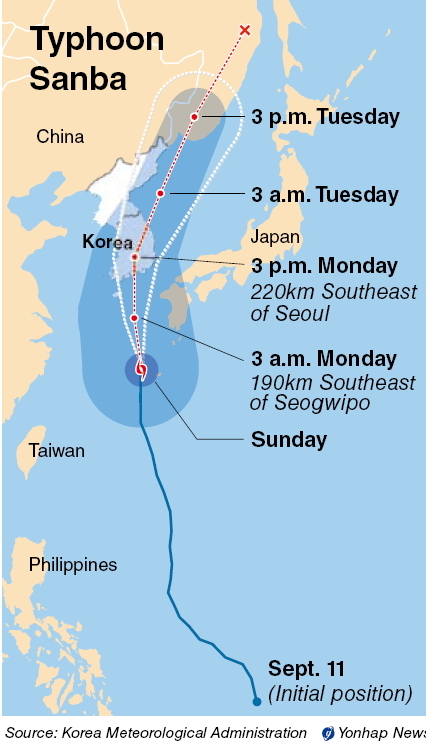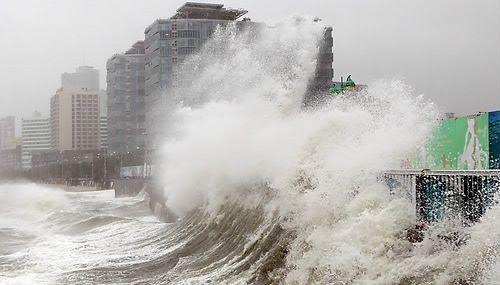
“Typhoon Sanba is medium-sized but is very strong on a scale of intensity,” the Korea Meteorological Administration said, calling for serious precautions.
As of 1 p.m. as it passed through Okinawa, Japan, the typhoon had central pressure of 935 hPa and winds of up to 48 meters per second. Winds of such a speed can derail trains in motion or uproot trees.

Sanba, the season’s 16th typhoon to hit the country, is expected to reach about 70 kilometers off Jeju around 9 a.m. Monday before making landfall near Yeosu, South Jeolla Province, in the afternoon. It is expected to pound the central region, including Seoul, at night.
It is expected to dump up to 400 millimeters of rain before moving out of the country early Tuesday.
Rainfall totals on Sunday were likely to be 150-400 millimeters in Jeju, 100-200 millimeters in southern regions, 50-150 millimeters in the Chungcheong and surounding areas and more than 50 millimeters in Seoul, according to the weather agency. Waves of 2-7 meters were forecast in southern and southeastern seas and 2-9 meters in other seas.
The Central Disaster and Safety Countermeasures Headquarters urged central and local governments to be fully prepared for possible damage, while advising people living in low-level and landslide-risk areas to evacuate.
All schools and kindergartens on Jeju Island were ordered to close Monday, while education authorities in other regions were mulling similar actions. Authorities also ordered suspension of ferry services and use of tower cranes at ports and shipyards, while banning entry to the nation’s 20 national parks.
Last month, typhoons Bolaven and Tembin struck the nation, leaving 25 dead, 5 missing and causing temporary power cuts for 2 million households.
By Kim Young-won (wone0102@heraldcorp.com)






![[From the Scene] Monks, Buddhists hail return of remains of Buddhas](http://res.heraldm.com/phpwas/restmb_idxmake.php?idx=644&simg=/content/image/2024/04/19/20240419050617_0.jpg&u=20240419175937)





![[Graphic News] French bulldog most popular breed in US, Maltese most popular in Korea](http://res.heraldm.com/phpwas/restmb_idxmake.php?idx=644&simg=/content/image/2024/04/18/20240418050864_0.gif&u=)


![[From the Scene] Monks, Buddhists hail return of remains of Buddhas](http://res.heraldm.com/phpwas/restmb_idxmake.php?idx=652&simg=/content/image/2024/04/19/20240419050617_0.jpg&u=20240419175937)

![[KH Explains] Hyundai's full hybrid edge to pay off amid slow transition to pure EVs](http://res.heraldm.com/phpwas/restmb_idxmake.php?idx=652&simg=/content/image/2024/04/18/20240418050645_0.jpg&u=20240419100350)

![[Today’s K-pop] Illit drops debut single remix](http://res.heraldm.com/phpwas/restmb_idxmake.php?idx=642&simg=/content/image/2024/04/19/20240419050612_0.jpg&u=)